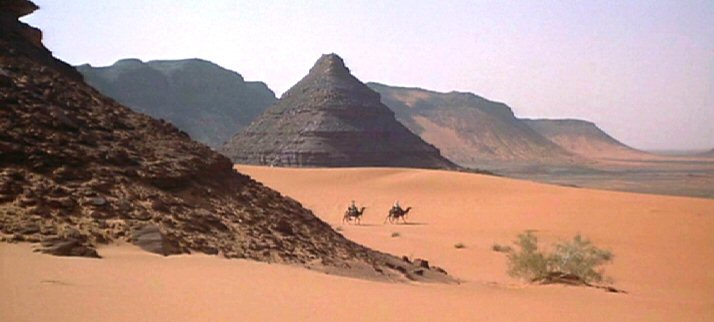
I am still struggling to rip the scenes I need from My Sjostrom DVD, so in the meantime I'll share a bit about landscapes from two online writers that I disagree with.
To start, I found Stewart McKie's article on Sys-Con Media, titled "The Role of Landscape in Film." He lists some of my favorite movies: Lawrence of Arabia, Dances with Wolves, Aguirre: The Wrath of God, etc., and goes on to describe the ways in which the landscapes within them "add additional depth to a story or the situation that characters find themselves in." I don't have a problem with that statement. In fact, I'd agree with most of what McKie says, when he includes a list of ways that landscapes can work in film:
- Reinforce themes
- "Raise the stakes"
- Create emotional highs
- Emphasise contrasting worlds
- Act as a character in its own right
But he leaves out an important element that I think Martin Lefebvre is keen to observe in the introduction to his volume, "Landscape and Film." Lefebvre's essential addition is that observation of landscapes often results in a removal or break from the narrative, because it privileges the aesthetics over the plot. McKie only discusses landscapes in ways that are more immersive to the viewer in the world of the story, if not the story itself. He sees landscapes not as opportunities for pause from narrative, but as extra tools to maintain the film's pull on the viewer, to root them in the story. I don't deny that what McKie says can happen, but I don't think landscape is always or merely an immersive element.
Yet again as I sought another online writer, I found Renee, a blogger and film-maker who again sees landscape as an opportunity to latch ever more strongly to the "world" or "atmosphere" of the story. In her case, she speaks of having worked on the movie "Twilight" as a painter, and discovered the ways that landscapes were so powerful to people. There is a real town called "Forks" on which Twilight fans have descended, because as Renee puts it, the land and landscape are a way to "enter into the story through a real-world portal." And that's something they tried to recreate on the set of Twilight.
So I'm bumped up against the question that challenges my assertion: Does landscape really immerse us more in the story, or does it offer us an opportunity to step back from it? Or both?
Neal, you're on a roll! Great thoughts! I had a few of my own before I read your final question. You posted "landscapes often results in a removal or break from the narrative, because it privileges the aesthetics over the plot." My thought was does it privilege or rather assist the plot and become a type of visual plot itself. I was thinking about that opening scene in the clip you showed in your "The Landscape View" post and thought about what that told me regarding the plot (as played out through dialogue). 1. it told me where, and when as well as showed a progression of of that "when" with the rising sun. Maybe landscape is a type of aesthetic plot. A picture can tell a story, why not a moving picture? Just as in a graphic novel (yes I'm using that again) the landscape us utilized as something to explore non-verbalized elements of the plot. http://www.scottishbooktrust.com/files/comics%20terminology_0.pdf
ReplyDeleteThis is a quick read and as I was looking at the "Layout" section, particularly under the sub-heading "graphic weight," maybe you could base your opinion on whether landscape assists the plot or not off of that. It's what formed my opinion. Hope it's helpful.
For me, landscape is a huge deal in film. I think most of my favorite movies draw me in with good use of landscape and physical setting. I just read your comment on my post about Google Earth, and I think it's worth considering what makes it so compelling. It gives you a sense of how your home or any given place is situated in relation to the surrounding world. I can see how that kind of widening of scope might be considered distracting from a subject in film, but I think it's that sense of place that makes it real and engaging. At least that's the way I think. I think the film Avatar (hey, see how I'm relating things we're discussing) owes a LOT of its success to creating a world rather than just a story. People were so drawn into "Pandora" that "Avatar Withdrawal Syndrome" became an topic worthy of discussion in articles like this one: http://www.cnn.com/2010/SHOWBIZ/Movies/01/11/avatar.movie.blues/index.html
ReplyDeleteMaybe that's an example on the extreme end of the spectrum.
In her blog post, I thought it was interesting how Renee basically compared the landscape of Bonanza to the other characters. For her, the landscape WAS another character. Well, do characters allow us to immerse ourselves more fully in the plot, or step back from it. I would say immerse us, because they become an integral part of what the plot really is. BUT do characters ever allow us to "break away" from the central plot. I think so. I'm thinking of the new Pride and Prejudice (which I really don't like too much. It's just not accurate) when the camera zooms in on Mary after Charlotte decides to marry Mr. Collins. In that second, you forget the pre-determined plot line. You start to wonder about other things, how the people lived, what it might be like if I was Mary, how I've felt ignored myself before. Is that the kind of break you are thinking of? If it is, and if landscape can be another character, then I think you'd have to argue that a good film maker could use a landscape to jolt his viewers out of the plot momentarily.
ReplyDelete